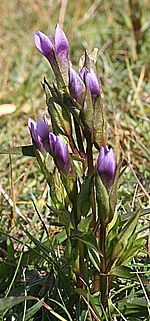Cutsdean Quarry facts for kids
Cutsdean Quarry is a special nature reserve in Gloucestershire, England. It's about 0.83 hectares (which is like two football fields!). This area is so important for wildlife that it's officially known as a 'Key Wildlife Site'. The Gloucestershire Wildlife Trust has been looking after it since 1981, working with the Stanway Estate.
Contents
Where is Cutsdean Quarry?
This quarry is located in the northern part of the Cotswolds, a beautiful area in England. You can find it near Heaver Cross-roads, about two miles north-east of a village called Temple Guiting.
A Look Back in Time
People aren't sure exactly when Cutsdean Quarry first started. But, old maps give us some clues! An old map from the Stanway Estate in 1865 shows the quarry was already there, but it was smaller, only about one acre. By 1883, another map shows it had grown bigger.
From Quarry to Nature Spot
Cutsdean Quarry is one of many old quarries in this area. These quarries were once busy places where people dug out limestone or slate. This stone was used to make roofing tiles for the famous Cotswold buildings. Cutsdean Quarry was used for limestone. Now, it's not used for mining anymore. Nature has taken over, creating different habitats like rocky areas, grasslands, and bushy spots.
Amazing Plants at the Quarry
Cutsdean Quarry is home to many interesting plants.
Plants on the Rocks
On the western side, where there are loose rocks (called scree), you can find plants like the pyramidal orchid. You might also spot the beautiful autumn gentian and wild mignonette.
Grassy Areas and Wildflowers
Other parts of the quarry are now covered in grass. Here, you'll see grasses like tor-grass and upright brome. Mixed in with these grasses are many lovely wildflowers. Keep an eye out for fairy flax, harebell, dropwort, field scabious, lady's bedstraw, quaking-grass, and woolly thistle.
Rare Finds and Shrubs
Long ago, a very rare plant called the perfoliate or Cotswold pennycress used to grow on the bare limestone rocks. Sadly, it hasn't been seen for a while. You'll also find lots of gorse bushes growing here. On the eastern side, there are patches of bramble and elder shrubs. Other common plants include cow parsley, common nettle, and rosebay willowherb.
Wonderful Wildlife at the Quarry
The quarry is a great place for spotting different animals, especially birds and butterflies.
Birds in the Bushes
Many birds love living in this habitat. You might hear or see linnets, whitethroats, tree pipits, and greenfinches.
Butterflies Fluttering By
If you visit, look for butterflies! The rare Duke of Burgundy butterfly has been seen here. You can also spot other beautiful butterflies like the ringlet, large skipper, and marbled white.
Reptiles Resting
This quarry is also a place where adders (a type of snake) like to bask in the sun.
Protecting This Special Place
The Gloucestershire Wildlife Trust works hard to keep Cutsdean Quarry healthy for all its plants and animals.
Helping Wildflowers Grow
To help the wildflowers thrive, the grassy areas are cut once a year. This stops strong grasses from taking over and gives the wildflowers space to grow.
Managing Shrubs
They also control the spread of plants like hawthorn and bramble. This helps make sure there's a good balance of different plants in the reserve.


